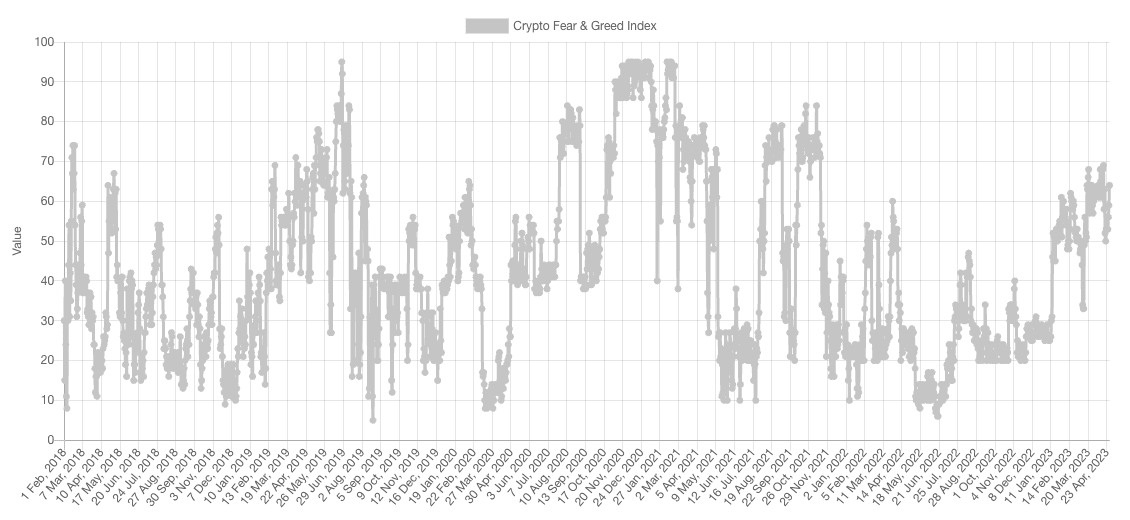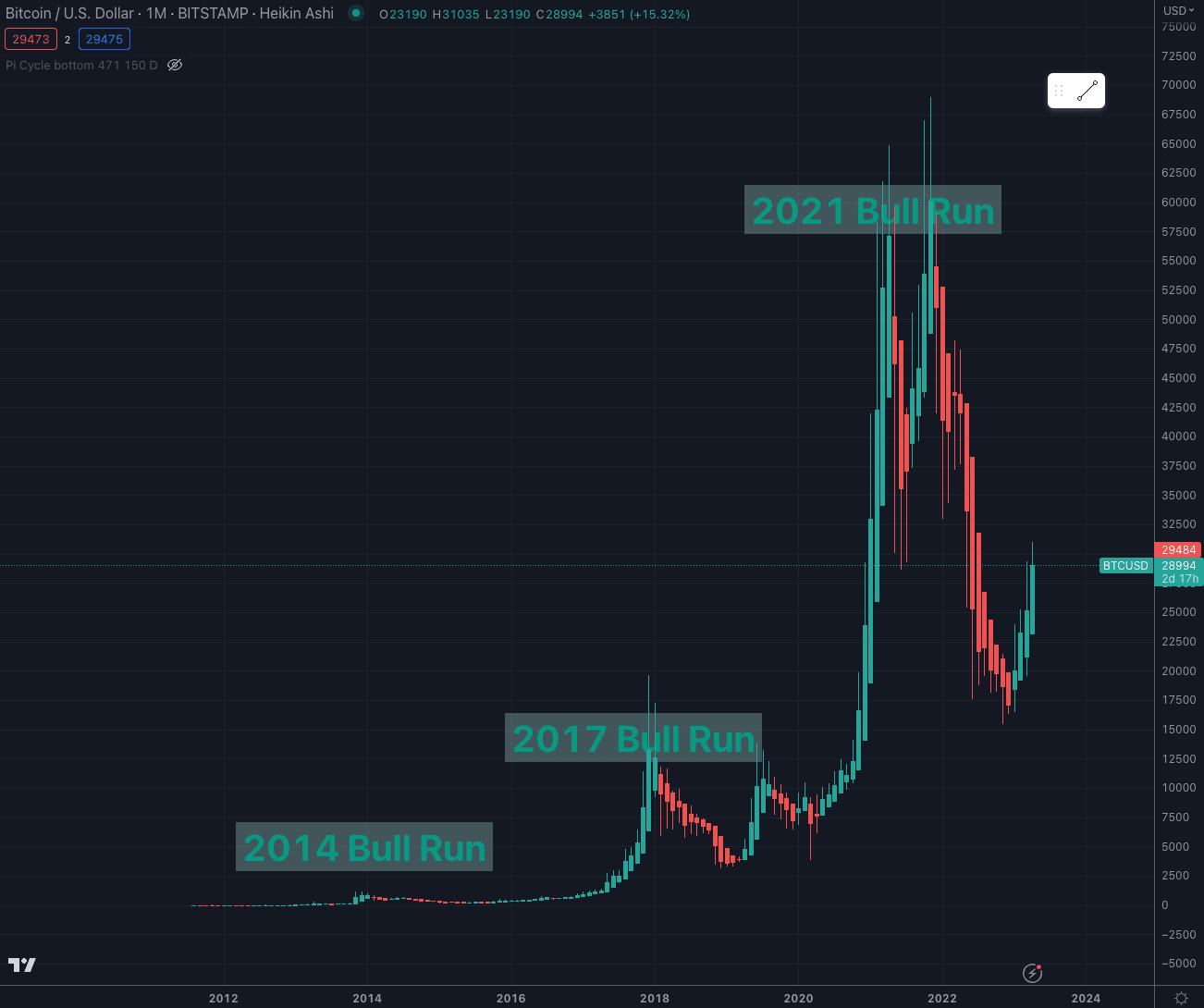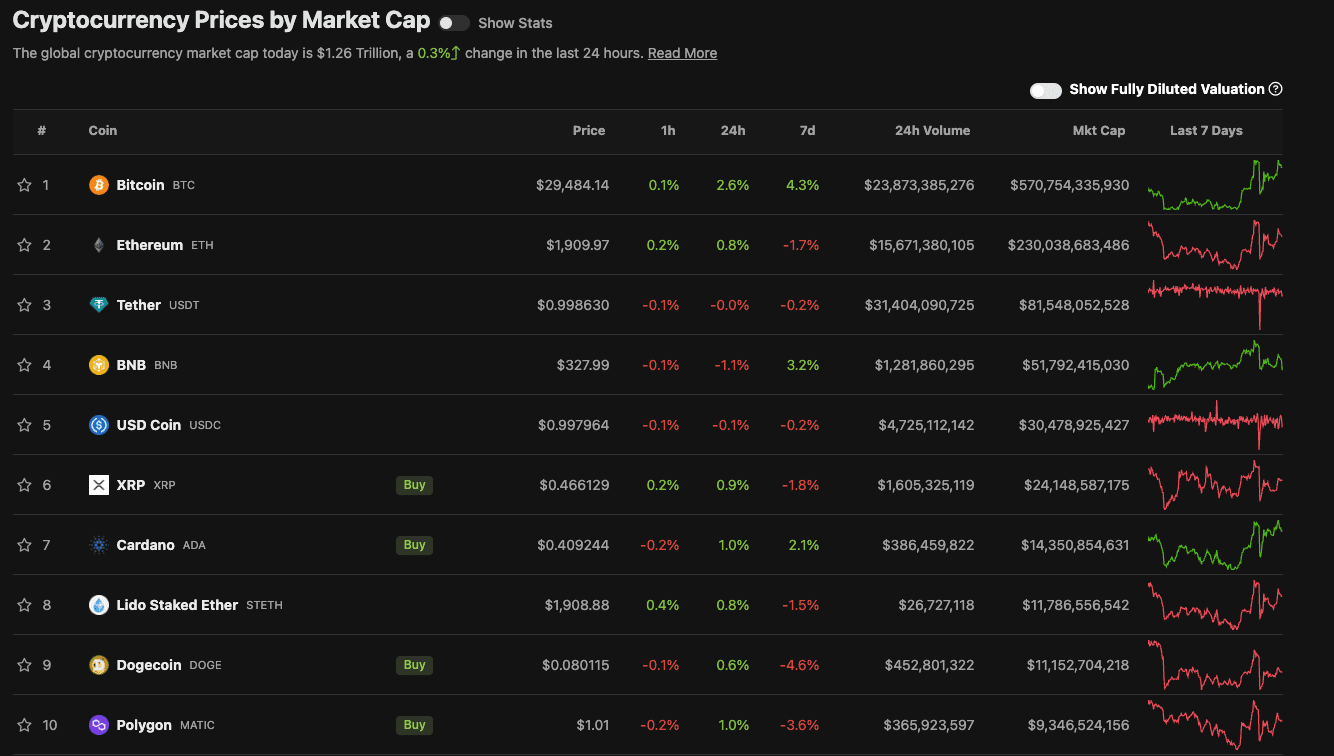The Rake Review: April 2023
The Rake Review: April 2023

April has been an interesting and volatile month (as we tend to have in crypto), with much industry news (discussed later) and market moves. Bitcoin is up around 8% for the month and the sentiment is more positive. So, it is a good time to ask ourselves where we are in the market cycle of crypto and how you can take advantage of that knowledge.
Why Market Cycles Happen:
The crypto market, like any other market, experiences cycles of ups and downs. These cycles are driven by a variety of factors such as investor sentiment (Greed and fear), the halving cycle, the macro cycle, and major developments in regulation and even major insolvencies. The cycles in crypto have historically been even more obvious than the economic cycle of boom and bust in traditional markets.
The Halving:
One of the reasons that crypto cycles have been so pronounced has been the impact of the bitcoin halving. The bitcoin halving was intentionally built into the bitcoin code. Every 4 years (roughly) the supply rate of new bitcoin halves. When bitcoin started 50 BTC were released through mining every 10 minutes, then it was 25 and so on halving every 4 years. Currently it's 6.25 per 10 minutes and the next halving is currently due 23rd April 2024 when the rate will be 3.125 BTC per 10 minutes. Generally, lower supply should lead to higher prices.
In our view the impact of these halvings over time should be reduced as the amounts we now see entering the market from miners is insignificant compared to major investors demand and the activities of funds. Also, given that the supply is already known for the next hundred years all this should theoretically be priced in. In reality, we’ve had a 4 year boom bust cycle over the last 12 years so it's highly likely we see another boom.

Market Psychology:
One of the reasons that market cycles happen is basic market psychology. Just like traditional markets, as prices rise investors get greedy and chase the prices further up. This in turn, pushes prices higher than they should have been (overheating) leading to an inevitable correction which destroys confidence and prices fall. Above is a graphic that shows this is human nature at play.
While every cycle is different and it is certainly hard to pinpoint the exact part of this cycle we can make some estimates based on the current levels of confidence and Bitcoin price action. We are certainly not in Euphoria or complacency. In the December 2022 Rake Review we noted that we may be in full blown "depression" stage. We are certainly out of that now as anger and depression are behind us. We seem to be tracking somewhere around “Hope” and “Optimism”.
To add weight to that call, below is a chart of the daily crypto fear and greed index. You might notice that the 2017 and 2021 Bull runs saw incredible readings of above 90 meaning greed had taken over which was a strong sell signal. There are also sub 10 readings covering peak fear times, the most recent of which was mid 2022 when Bitcoin had halved in price from its peak and the Luna debacle was playing out. Currently the index shows a reading above 60 showing people are actually starting to be bullish. The price of almost $30,000 USD correlates to this nicely as we have already recovered significantly from the local low’s set after FTX filed for bankruptcy.

Firstly, just knowing we are heading into a possible bull run doesn’t mean you should go out and buy all the Bitcoin you can. We have seen multiple instances of Bitcoin retesting lows as part of its recovery (most notably in late 2019- shown below) and if that happens again you might be well placed to wait and see if you can snap up some cheap Bitcoin on the dip.

In February we wrote:
“We are in a Buy the Dip environment that rewards those that have high conviction and are not afraid to buy when others are fearful. The market seems to be bouncing back after every dive rewarding steady investors.”
This statement has rung true over the last 2 months and you would have done really well buying every dip on the way.
Secondly, there is still significant risk around the macro environment. Many pundits expect a significant recession across the US and Australia as higher interest rates bite hard. If that scenario plays out we could see a credit crunch. We could see investors being forced to liquidate their bitcoin to save their home. In this scenario it would not be crazy to see a retest of $17,000 USD levels. However, if you are sitting on a position of zero you may be a little crazy because we are under a year off the halving event and there is a genuine chance you could miss the next bull run.
History Does Not Repeat Itself, But It Rhymes”. This time will be similar but different. You have to take into account current circumstances when assessing how this cycle will look. One point is the macro environment already discussed but the second point is that there is way more institutional money in the space than their was. The lows might be higher and the highs lower. With maturity comes less long term volatility. It’s also possible that the cycles shorten their span as the influence of halvings wain, bitcoin matures into an investable asset and the market increases in size. We would not be surprised if this bull run starts earlier than the 4 year cycle suggests.
More:
If we continue to see prices lift we may well see even greater volatility. Bull runs are always volatile. Also, we may see the whales try to “shake out” retail investors that are happy with 20% returns or finally hitting break even. Hold onto your BTC if you can.
Truth in Government:
Above, is the US Treasury official projection for Budget 2023. Notice anything askew? Total Receipts in Green are 2.0 Trillion and Deficit is 1.1 Trillion (about the size of Australia’s entire GDP). Yet the Deficit looks tiny. Hmmm. I don’t think this is to scale. What if we redid it to scale?

Market Update

Here is the fast five of what you need to know about the market in November 2022:
- Bitcoin has continued its march onwards passing $30,000 USD briefly before retesting $27,000 USD. Currently it is looking to reclaim the $30K level.
- Ethereum had a great month including a flawless upgrade to Shapella. This means that stakers can now un-stake and the positive news pushed ETH past $2,000 briefly.
- The total crypto market cap is well above a Trillion now.
- DOGE performed well after Elon changed the Twitter bird to the DOGE logo.
- BNB under performed following multiple law suits from the CFTC, SEC and Private.
Video of the month
Gary Gensler was grilled by congress for the SECs poor performance in protecting investors, as well as its lack of clarity and damage to the crypto industry as a whole.
In the news
- Binance pulls the pin in dispute with the Australian regulator and cancels its AFSL. Binance also has multiple law suits lined up against it as the regulators go after them and the founder CZ for allegations of wrongdoing including trading against its clients.
- Apple Launches a high yield savings account. It may be currently powered by traditional banks but this is a gateway to digital assets. Watch this space.
- The significance of the BRICS expansion are starting to be noticed as the US Treasury Secretary says Sanctions could hurt the US dollar.
- The SEC brings action against Bittrex
- The SEC brings a wells action against Coinbase and Coinbase hits back hard. We expect Coinbase to put up a strong fight against the SECs poor guidance and enforcement heavy stance. Also, Coinbase went after a Bermuda licence and signalled a move away from the US in response to regulatory uncertainty.
- Congress grills Gary Gensler’s role at the SEC. Here are 3 highlights (3-4min each)
- Mr McHenry - Is ETH a security or commodity?
- Mr Davidson - Big gripes with the SEC and a proposal to replace Gary Gensler & the SEC.
- Mr Emmer - SEC is hurting the crypto industry and pushing it offshore.
- ETH Shapella + Shanghai upgrade completed successfully, allowing users to un-stake their ETH.
Education
Education
The Bitcoin Halving Phenomenon and the Magic Number 21 Million
Two essential aspects that set Bitcoin apart from traditional currencies are the halving events and the maximum supply of 21 million coins. In this article, we will delve into the mechanics of Bitcoin halving and examine the significance of the 21 million cap.
Understanding Bitcoin Halving
As we mentioned in the introduction, Bitcoin issuance reduces over time. Bitcoin halving occurs every 4 years or more accurately 210,000 Blocks.
The halving mechanism was implemented by Bitcoin's creator, Satoshi Nakamoto, to control the rate of new coin issuance and combat inflation. The process mimics the concept of scarcity found in precious metals like gold, where limited supply can increase value over time. The gap of 4 years between each halving plays an important effect in human physiology by having a more dramatic market cycle as people rush in as the impact of the halving takes effect. We think this was a feature not a bug.
Part of the beauty of bitcoin, is you can run your own bitcoin node, inspecting the bitcoin software, and see for yourself that your bitcoin complies to the rules Satoshi set out. Below is the section of the bitcoin code that calculates how much bitcoin is issued per block.

An explanation of the statements within is as follows:
int halvings = nHeight / consensusParams.nSubsidyHalvingInterval;
Determine which halving we are up to by dividing the current block number (height) by 210,000
if (halvings >= 64) return 0;
After 64 halvings the subsidy is no longer calculated.
CAmount nSubsidy = 50 * COIN;
The subsidy starts at 50 bitcoin per block
nSubsidy >>= halvings;
The subsidy is “halved” for every halving. ">>" is a “right shift” operator where >> 1 is half >> 2 is a quarter >>3 is an eighth etc.
The 21 Million Cap: A Finite Supply
Bitcoin's protocol dictates that there will only ever be 21 million coins in existence. This cap ensures that Bitcoin remains a deflationary currency, as opposed to traditional fiat currencies, which are often inflationary due to central banks' ability to print money at will.
The decision to cap Bitcoin's supply at 21 million coins was also influenced by the desire to create a predictable monetary policy. This finite supply, coupled with the halving events, allows market participants to anticipate changes in Bitcoin's supply and adjust their investment strategies accordingly.
Significance of Bitcoin Halving and the 21 Million Cap
The combination of halving events and the 21 million coin cap has several implications:
- Inflation Control: Bitcoin's controlled supply reduces the risk of inflation, maintaining the currency's purchasing power over time. This characteristic has led some investors to view Bitcoin as a hedge against inflation.
- Increasing Scarcity: As the mining rewards decrease and the number of new coins entering circulation slows, Bitcoin becomes more scarce. This scarcity can contribute to an increase in value, as long as demand for the cryptocurrency remains robust.
- Mining Incentives: The halving events also serve to maintain the balance of incentives for miners. As the mining reward decreases, the transaction fees become a more significant part of miners' income, ensuring that they continue to support the network even as the block reward diminishes.
- Market Predictability: The predetermined monetary policy of Bitcoin allows market participants to better anticipate changes in the cryptocurrency's supply. This transparency can contribute to more stable long-term investment strategies and more confidence in the entirety of the system.
The Future of Bitcoin and the 21 Million Cap
As of now, over 19.3 million Bitcoins have been mined, representing approximately 92% of the total supply. It is estimated that the last Bitcoin will be mined around the year 2140. As the mining rewards continue to diminish and the 21 million cap approaches, the dynamics of the Bitcoin network will evolve.
Memes of the month


Start Your Brokerage Account
If you enjoyed this Rake Review, feel free to open an account and gain access to more proprietary research and work with your very own dedicated crypto broker.
No Advice Warning
Disclaimer
All statements made in this newsletter are made in good faith and we believe they are accurate and reliable. Stormrake does not give any warranty as to the accuracy, reliability or completeness of information that is contained here, except insofar as any liability under statute cannot be excluded. Stormrake, its directors, employees and their representatives do not accept any liability for any error or omission in this newsletter or for any resulting loss or damage suffered by the recipient or any other person. Unless otherwise specified, copyright of information provided in this newsletter is owned by Stormrake. You may not alter or modify this information in any way, including the removal of this copyright notice.Copyright © 2022 Stormrake Pty Ltd, All rights reserved


